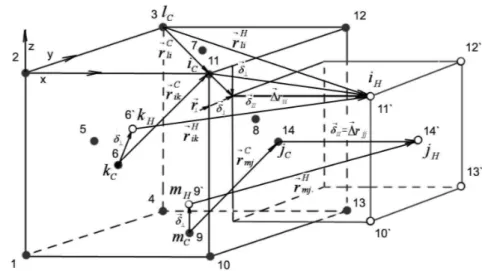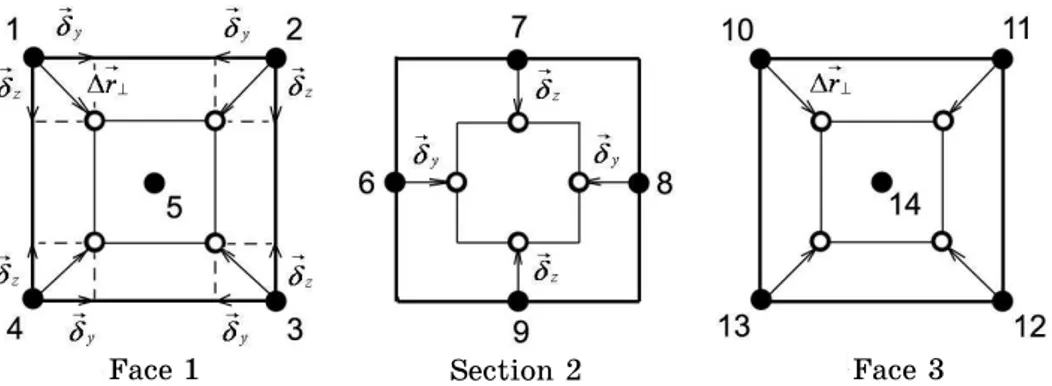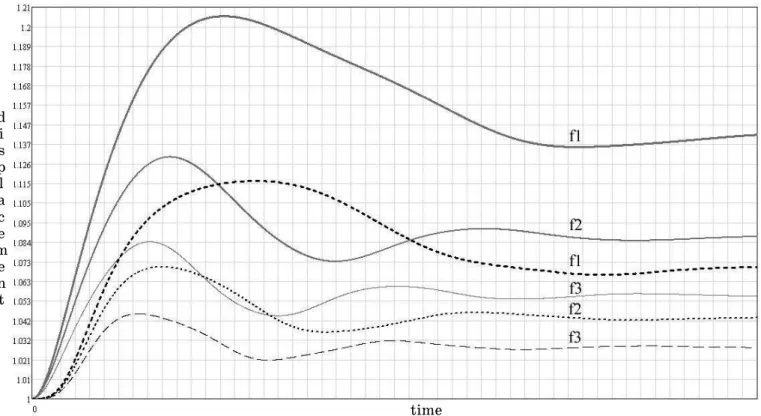J. Nano.- Electron. Phys.
1 (2009) No1, P. 62-70 (Sumy State University) 2009 SumDU
62
PACS numbers: 81.40.Lm; 81.40.Lm; 62.20.F –
DEFORMATION DYNAMICS OF THE SOLID STRUCTURAL UNIT FROM AN EXTERNAL ACTION
A.A. Mochalov, A.A. Gaisha, K.D. Evfimko
Admiral Makarov National University of Shipbuilding, 9, Geroev Stalingrada Ave., 54025, Nikolaev, Ukraine E-mail: idept@usmtu.edu.ua
In this work we present the model for study the solid deformation dynamics based on the structural unit method. The solution results of some model equations are given. Time dependence of the sections relative displacement of a structural unit during the uniaxial longitudinal deformation is graphically represented.
Keywords: SOLID DEFORMATION, STRUCTURAL UNIT METHOD, UNIAXIAL
LONGITUDINAL DEFORMATION, MATHEMATICAL PROCESSES SIMULATION, GENERALIZED POTENTIAL.
(Received 22 April 2009, in final form 14 May 2009)
1. INTRODUCTION
The present-day world is in significant want of new structural materials, and the requirements to their strength, operating life, high-temperature strength, stability against dynamic loads and to other characteristics rise. Under these circumstances the development of theoretical justification, practical methods of research, analysis and synthesis, and the methods of modern materials production as well is the task of fundamental and applied science. Computational techniques have been essentially developed, what, in its turn, gave an application possibility of new methods and models for theoretical study of properties of the solids. The study of kinetic aspects of deformation process, sample loading-rate effect on the coefficients of its equation of state, and different short-term processes are especially relevant. The experimental investigations are also carrying out in this field now [1-3], which can be used for experimentally-theoretic models, and for study the mathematical models with respect to their adequacy of reality as well. 2. STATEMENT OF THE PROBLEM
non-DEFORMATION DYNAMICS OF THE SOLID STRUCTURAL UNIT… 63
applicability to the real crystal structures of the metals, conditioned by considerable complexity of transition from the plane problem to the solution of equation for three-dimensional structure.
The aim of the present work is development of the method, which allows to study the solid deformation dynamics on the base of theoretical model and experimental data.
3. STRUCTURAL UNIT METHOD
Proposed in the present work the structural unit method (cell method) is similar to the particle method, but differs by the following: the structural unit consists of individual particles, which configuration depends on matter structure and essentially influences on its properties. Configuration can be obtained using the diffraction method [8, 9]. In this work we consider the uniaxial deformation dynamics of the face-centered cubic (fcc) structure of metals and alloys, but this method is applicable to other types of crystal structures [10-12] as well. As the interaction potential between the structural unit elements (atoms) the generalized potential of the type of Ï(r) – D(e–2Ar – 2e–Ar) is used, which is adapted to the real experimental
investigations. The potential parameters essentially depend on thermo-dynamic parameters and are connected with the macroscopic properties of investigated solid: D(P, T) is the dissociation energy (the bond breaking energy); r is the vector of atom displacement from equilibrium position; A is the constant, dependent on the nature of corresponding matter. We have to note, that it is possible to use other potentials, particularly: the Lennard-Jones potential, the Morse potential, the spline potential, the generalized one, and others, which are adapted to the defined matter structure [13-14]. Consider the fcc metal lattice, where the external stretching force F is applied to its face. Under acting of this force the structural unit (fcc cell) is deformed in force direction, and in this case the interatomic distances gradually change, since the interacting forces f(r) – dÏ(r)/dr between the lattice atoms start acting, conditioned by the interaction potential Ï(r), where r is the vector of interatomic distance changes.
The resultant interaction force, acting on the i-th atom in a cell, is the vector sum of all forces, acting on the atom in deformation direction.
1,
( ik) n ( ) cos( , )ik ik
Pi Pi
i i k
f r f r r F , (1)
64 A.A. MOCHALOV, A.A. GAISHA, K.D. EVFIMKO
Fig. 1 – Diagram of the forces, acting in the sections of deformed cell
In vector form the interconnection of coordinate vectors rik and rmj with displacement vectors | |, , rii, rjj for the interaction of i-th and k-th, m-th and j-th, l-th and i-th atoms, entered into the structural unit, will be written in the form:
| |
C H
ii
ik ik
r r r ,
| |
C H
li li
r r r ,
C H
jj
mj mj
r r r , (2)
ii jj
r r r ,
| |
jj ii
r r ,
2
r ,
where C, C mj ik
r r are the radius-vectors between the corresponding atoms of a cell before deformation (old), H, H
mj ik
r r are the radius-vectors between the corres-ponding atoms of a cell after deformation during the given time interval (new). In Fig. 1 we represent the interconnection of vectors, which condition an interaction between the corresponding atoms, entered into the structural unit before and after interaction of the i-th, k-th, m-th, j-th, l-th atoms (atoms are assigned the numbers 1…14, the stroke denotes position after deformation), with vectors of the longitudinal II and the lateral cell deformations, where iC, kC, mC, jC, l are the notations of the particles
(atoms) in initial state, and iH, kH, mH, jH, lC are the notations of the corresponding atoms in a new state, C, C, C, H, H, H
mj li mj li
ik ik
DEFORMATION DYNAMICS OF THE SOLID STRUCTURAL UNIT… 65
Substituting H ik
r and cos( , )r Fik into expression (1) for the force ( )f ri ik and summarizing over the directions x, y, z for all cell atoms we obtain
stretching forces
1,
( ) cos( , ) n
xi i ik ik
i i k
f f r r x – along the x axis;
pressing forces
1,
( ) cos( , ) n
yi i ik ik
i i k
f f r r y – along the y axis; (3)
1,
( ) cos( , ) n
zi i ik ik
i i k
f f r r z – along the z axis.
Under consideration of uniaxial longitudinal deformation the fcc cell can be conditionally divided into two faces and one section, respectively, the face 1, the face 3 and the section 2 (see Fig. 2). Proceeding from the symmetry, the resultant force, acting on the faces and the section along the deformation vector, subject to (1) will be written as:
for the face 1
4
1 5
1
1 4
x xiP x P
i
f f f ;
for the section 2
9 2 6 1 2 x xiP i
f f ; (4)
for the face 3
13
3 14
10
1 4
x xiP x P
i
f f f .
Forces, acting in transverse direction of deforming force F, in the cell planes 1, 2, 3, expressed in the terms of deformation vectors and coupling stiffness coefficients k 1, k 2, can be written as follows:
in the faces 1, 3:
2 2
1 1 2
ik y z
f k k (for i 1-4 and i 11-14),
2 2
ik y
f k k (for i 6-9), (5)
y z, k 1 and k 2 are the coupling stiffness coefficients for atoms in the section 2 and the faces 1,3.
The directions of deformation vectors, acting in the cross-sections 1, 2, 3 in a structural unit, are showed in Fig. 2.
It is follows from (5), that stretching forces in the sections 1, 2, 3 are different, and, correspondingly, the stiffness coefficients will be different as well.
66 A.A. MOCHALOV, A.A. GAISHA, K.D. EVFIMKO
Fig. 2 – Schematic representation of the deformation vectors directions
Taking into account that the energy scattering coefficient in a cell and the stiffness coefficient of interatomic bond k are functions of the deformation vector that is (r) and k(r), the equation of motion of reduced masses will be essentially nonlinear with variable coefficients. In the linearized form the equations of motion of reduced masses in a cell (see Fig. 3), expressed in terms of deformation velocity d r/d for the i-th time moment with initial conditions 0 and r 0, can be written as follows:
for the mass m1
1 1 1
1 1 1 * 1 *
1 1
0
( ) 2
i i i
i i i
d r k F
r r dr
d m m ; (6)
for the mass m2
2 2 1
1 2 * 2 *
2 2
0
( ) 2
i i i
i i i
d r k F
r r dr
d m m , (7)
where ri d r di is the deformation velocity in the i-th time moment for the corresponding masses; 1i and 2i are the scattering (dissipation) coefficients under the corresponding deformation ri; k1i and k2i are the
stiffness coefficients of interatomic bond under the corresponding deformation ri; F( ) is the time-varying external force; f12 and f23 are the interatomic interaction forces, acting in the sections 1, 2, 3 along the deformation force.
Forces f12 and f23 are calculated using expressions (1) and (4) for every time moment. An increment of deformation vector in the i-th time moment for the corresponding masses can be evaluated with expression
0 i
r r dr. (8)
The correlation of interatomic distances r12, r23, r34 in the i-th time moment during the reduced masses displacement from the equilibrium position can be presented as follows:
DEFORMATION DYNAMICS OF THE SOLID STRUCTURAL UNIT… 67
Fig. 3 – Forces action on the reduced masses in an arbitrary time moment under the
external force F( ) influence. Dots denote the initial positions of reduced masses in a cell; asterisks present the positions of reduced masses in a cell in an arbitrary time moment
0 0
12 ( 1 2), 23 ( 2 3)
2 2
i a i i i a i i
r r r r r r . (9)
The deformation work of a structural unit (cell) can be expressed with the interaction potentials in a new Ï( H)
ik
r and an old Ï( C) ik
r states, and with the deformation vectors r 2, rjj | | rii using expressions (2) as well
1, 1,
1, 1,
Ï( ) Ï( ) ( ) cos( , ) ( ) cos( , )
( ) cos( , ) ( ) cos( , ) .
n n
T H C H H C C
II i i
ik ik ik ik ik ik
def
i i k i i k
n n
H H C C
i ik ik i ik ik
i i k i i k
A r r r f r r x f r r x
r f r r y f r r y
(10)
On the other hand, the deformation work can be calculated using the experimental data
( )
E H C
c c c
def
A V V V , (11)
where F/S( ) is the stress acting in a cell section, F is the external force applied to a cell face, H, C
c c
V V are the cell volumes, respectively, during and before the force F application.
The volumes change can be expressed in terms of the cell size a0 (at T T0) and the deformation vectors magnitudes
2
2 2
0
| | || | |
0
2 2
2 ( ) 4 ( ) 4
2
2 2
c
r
V a r r a r r r r . (12)
68
A.A
.
MO
C
HAL
OV
, A
.A
. GA
IS
HA,
K.
D
. EV
FI
MK
O
time d
i s p l a c e m
e n t
DEFORMATION DYNAMICS OF THE SOLID STRUCTURAL UNIT… 69
Based on this data it is possible to calculate the cell volume changes with time
0 0
( ) ( ) ( )
S l
c
S l
V S d l d . (13)
Equations (6)-(8) subject to (1), (4), and (9) allow to investigate the defor-mation dynamics based on the theoretical model and along with experimental data to generate the functionals: the forcing, the high-speed, and the deformative. Based on expressions (3) and (10)-(13) subject to dÏ(r)/dr – f the energy and the forcing functionals are formed, which allow to correct the interaction and the force potential in accordance with experimental data. 4. CONCLUSIONS
Based on the force functional the interacting forces between atoms, entered into the unit fcc-cell, are calculated, what gave a possibility to derive the cell sections displacement with time under the external force F action. The energy functional is used for description of the energy charac-teristics of the solids: the thermal capacity, the entropy, and the cell internal energy. The high-speed and the deformative functionals allow based on the experi-mental investigations of the sample deformation (structural unit) to correct the theoretical energy and forcing functionals relative to the deformation velocity. Minimization of these functionals gives a possibility to calculate a number of values versus the sample loading rate and create the equation of matter state, which the most closely defines the matter state in the different ranges of deformations, deformation velocities, and temperatures.
As the result of equations (6) and (7) solution the dependencies of the relative displacement of the fcc-cell sections with time during the uniaxial longitudinal deformation under the external force action are obtained. As seen from Fig. 4, the stretching force essentially influences the transient process. Delay of the sections displacement takes place due to inertial properties of a matter. The data of equation allows to study the deformation dynamics of a solid at different values of the external deforming force using parameters of the generalized potential (the dissociation energy A) and experimental data (the cell structure, the interatomic distance, and the external force value). Proposed model allows to explain the nature of deformation phases from the physical point of view.
REFERENCES
1. G. Kolskiy, Mehanika No4, 108 (1950).
2. A.M. Bragov, A.K. Lomunov, Prikladnye problemy prochnosti i plastichnosti No51, 127 (1995).
3. A.A. Mochalov, K.D. Evfimko, Visnyk SumDU. Seriya Fizyka, matematyka, mekhanika No1, 156 (2008).
4. V.K. Golubev, A.A. Seleznev, Khimicheskaya fizika 21 No10, 61 (2002).
5. V.P. Tsymbal, Matematicheskoe modelirovanie metallurgicheskih processov (M.: Metallurgiya: 1986).
70 A.A. MOCHALOV, A.A. GAISHA, K.D. EVFIMKO
7. A.M. Krivtsov, N.V. Kravtsova, Dal’nevostochny matematicheskiy zhurnal DVO RAN 3 No2, 254 (2002).
8. L.M. Utevskiy, Difraktsionnaya elektronnaya mikroskopiya v metallovedenii (M.: Metallurgiya: 1973).
9. Ya.S. Umanskiy, Yu.A. Skakov, A.N. Ivanov, L.N. Rastorguev, Kristallografiya, rentgenografiya i elektronnaya mikroskopiya (M.: Metallurgiya: 1982).
10. A.S. Davydov, Teoriya tverdogo tela (M.: Nauka: 1976). 11. U. Kharrison, Teoriya tverdogo tela (M.: Mir: 1972).
12. A.M. Kosevich, Osnovy mehaniki kristallicheskoy reshetki (M.: Nauka: 1972). 13. U. Kharrison, Psevdopotentsialy v teorii metallov (M.: Mir: 1968).



